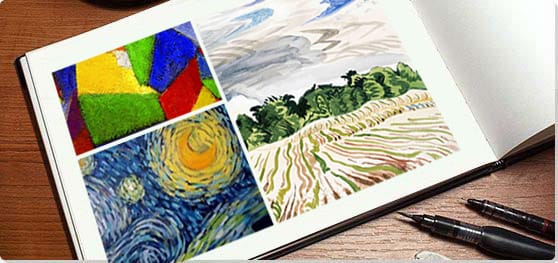Summary of Synesthesia
From the Greek meaning "union of the senses”, synesthesia refers to the experience of information pertaining to one sense through the organs of another: for example, it might involve seeing sound, hearing music, or smelling color. While synesthesia is a relatively rare condition, it is estimated that about five percent of us experience it. Moreover, amongst artists and creatives the proportion of synesthetes is thought to be much higher, with overlapping sensory experiences proving a source of creative inspiration and intrigue for centuries. This became particularly true in the wake of the Romantic era, which prized all forms of intense and unusual psychological experience. In the modern epoch, the Symbolists, Impressionists, Expressionists, Synchromists, and many others turned to synesthesia for inspiration, while recent advances in neuroscience allow us to map and define the effects of synesthesia in new ways.
Key Ideas & Accomplishments
- The most common form of synesthetic experience amongst artists is chromesthesia, whereby sound, and particularly music, can be experienced as color. Indeed, this condition could be seen to have had a profound effect on the development of abstract art during the early twentieth century, because important artists in the field such as Wassily Kandinsky were inspired by their experiences of chromesthesia.
- The experience of synesthesia had a particular impact on the early modern art through the achievements of two major movements, Symbolism and Impressionism. Both schools were concerned with mapping affinities between sound and image, notably through the Nocturne Impressionist paintings of James Abbott McNeill Whistler. The American Synchromist movement, working in the wake of Impressionism, made the most concerted attempt of the modern era to codify synesthesia as a resource for painting.
- One common misperception concerning synesthesia is that it denotes mental illness or madness. This has previously caused the experiences of synesthetic artists such as Vincent Van Gogh to be written off as symptoms of emotional malady, when they might have been nurtured as sources of creative inspiration. Contemporary psychology and neuroscience invite us to take a more sympathetic view of synesthetic experience.
The Important Artists and Works of Synesthesia
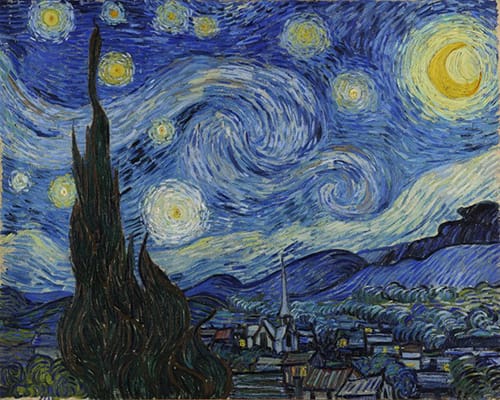
Starry Night
Dutch artist Vincent van Gogh is believed to have been a synesthete, based on countless statements he made in his lifetime indicating that he experienced associations between color and music. In a letter to his brother Theo in 1881, he wrote that “[s]ome artists have a nervous hand at drawing, which gives their technique something of the sound peculiar to a violin.” In 1883, when he was about 30, he began studying piano, because, as his student Anton Kerssemakers explained, he was “always comparing painting with music, and [wanted to learn piano] so as to get a better understanding of the gradation of tones.” Shortly after beginning his lessons, van Gogh reported having the bizarre experience of “seeing” a different color with every note he played. His piano teacher, Hein van der Zanden, was so disturbed by this that he refused to continue the lessons, and declared that van Gogh was evidently a “madman.” Neurosurgeon Camilla de Laurentis notes that, “Although he was a synesthete, [van Gogh’s] artworks are not immediately synesthetic. Nevertheless, some observers claim to hear the voice of joy and hope when looking at his yellows.” Indeed, the artist once stated that some shades of blue and yellow were “like fireworks” to his senses, and these tend to be the dominant hues of many of his works. Armed with this knowledge, we can begin to view works like Starry Night (1889) in a new way. Rather than viewing his energetic, visible brushstrokes as a fanciful, post-impressionistic way of representing visual “reality,” we can begin to wonder what sounds and emotions are really being presented here. Van Gogh’s story also serves as a cautionary tale against the erroneous, yet still commonly-held belief that synesthesia is a form of insanity or disability. While he no doubt suffered from other forms of mental disturbance throughout his life, the fact that his synesthesia was viewed, for instance by his piano teacher, as a freakish aberration may likely have caused the artist to not fully embrace it for what it really was: a gift.
Oil on canvas - Museum of Modern Art, New York, New York
The Insect Chorus
Though we do not know for certain whether or not American painter Charles Ephraim Burchfield was actually a synesthete, his artworks powerfully convey synesthetic experience. Burchfield preferred using watercolors rather than oil or acrylic paint. Curator Greta Berman explains that Burchfield, in his journal, often “expressed dissatisfaction with his few, halting attempts in oil. The main difficulty of capturing synesthetic photisms (or visions) in paint […] is the fact that they are in constant motion. […] Burchfield […] sought to portray the movement of the sounds he observed via the rapidity of watercolor.” Critic and historian Benjamin J. Townsend notes that Burchfield’s method of “composing rhythms and colors with designs that could allow viewers to ‘receive the same sensations as on listening to notes’ […] anticipates Walt Disney’s use of the device in his animated films, especially Fantasia (1940).”
The majority of Burchfield’s ouevre is comprised of fantastical and romantic landscape scenes, which are executed in a highly unique, personalized style, with Burchfield including lines, shapes, and objects extraneous to that which can be observed in nature. For example, his Insect Chorus (1917) shows a scene of a garden, but contains several visual elements that refer to the non-visual experiences of a child in that space. Burchfield provided an explanation of the image in his journals, writing: “[i]t is late Sunday afternoon in August. The child stands alone in the garden, listening to the metallic sounds of insects. They are all his world, so to his mind, all things become saturated with their presence. Crickets lurk in the depths of the grass, the shadows of the trees conceal fantastic creatures, and the boy looks with fear at the black interior of the arbor, not knowing what terrible thing might be there.” The “metallic sounds of insects” are made visible in the work, in the jagged lines that reverberate above the grass and in the bushes. Meanwhile, curved, swirling, and spiraling black lines at the top right corner suggest the whooshing sound of the tree’s leaves in the wind.
Opaque and transparent watercolor with ink, graphite, and crayon on off-white paper - Munson-Williams-Proctor Arts Institute, Museum of Art, Utica, New York
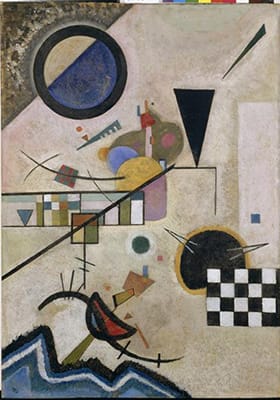
Opposing Accords
Russian painter Wassily Kandinsky was an advocate for abstraction in visual art as a means to access the realm of emotions and the spiritual, and elaborated these views in his influential 1910 book Concerning the Spiritual in Art. He viewed music as the pinnacle of such abstract expression, and created several paintings, as well as experimental “stage compositions,” inspired by musical compositions. He was also a synesthete and once stated “the sound of colors is so definite that it would be hard to find anyone who would express bright yellow with bass notes or dark lake with treble.” He abandoned his career as a law professor after he had a particularly powerful chromesthetic experience during a performance of Wagner’s Lohengrin at the Bolshoi Theatre in Moscow. He said of the experience, “I saw all my colors in spirit, before my eyes. Wild, almost crazy lines were sketched in front of me.” He went on to study painting in Munich and dedicated the remainder of his life to making art.
Kandinsky entirely rejected figurative representation in his work, favoring instead shapes, lines, and discordant color combinations (which he viewed as the visual analog to atonal music). Opposing Accords (1924) is an excellent example of this, with its asymmetrical composition and use of discordant color combinations, as well as its use of bold, sharply outlined shapes that appear to “clash” or be in conflict with one another. Anyone familiar with musical notation will recognize the similarities between this image and a musical score for a work of atonal jazz music. As neurosurgeon Camilla de Laurentis asserts, the artwork “evokes opposites and specifically contrasting tunes.” She explains that “according to the artist, an artwork should express an equilibrium of tensions in order to produce the desired effect or ‘maximal sound’ through the opposition of elements. First of all, the contrast is between the two circles, one on the left and one on the right. Secondly, the audience can perceive opposition while looking at yellow and blue in the upper circle, which in turn opposes the zig-zagged line at the bottom.” The title of the painting also reinforces this idea of discordance.
Oil on cardboard - Centre Pompidou, Paris, France
Salut Tom
A New York Abstract Expressionist painter, Joan Mitchell experienced associations between colors, sounds, and emotions as well as having an eidetic (photographic) memory and what Mitchell’s biographer Patricia Albers calls “porous consciousness.” Alberts goes on to define this term as “her sometime inability to distinguish between herself and the landscapes and people she loved” (for example, she “intensely experienced sunflowers […] and she physically felt their dying”). Sadly, Mitchell’s life was characterized by constant shame, repression, and trauma. Her father was emotionally abusive, wishing the artist had been born male. She also experienced rape while visiting a friend in a mental hospital, underwent a number of abortions, and suffered physical abuse at the hands of several of her lovers and partners, including Quebecois painter and sculptor Jean-Paul Riopelle. Mitchell also suffered from alcoholism.
According to Albers, for Mitchell, “depression was silvery white. Absolute horror.” By contrast, “dark green was loneliness. Yellow, hope.” It is only with this knowledge that we can fully appreciate a seemingly abstract work like Salut Tom (1979), created as an homage to her friend, art critic and curator Thomas B. Hess, who had passed away due to a heart attack one year prior to the painting’s creation. Across the four panels, strokes of dark green (loneliness), yellow (hope), and white (depression) take on different arrangements, representing the emotional states that Mitchell passed through as she grappled with the grief of losing her friend.
Oil on canvas - National Gallery of Art, Washington D.C.
Stage Design for Turandot (performed at Lyric Opera of Chicago)
British Pop artist David Hockney is a synesthete who experiences chromesthesia (the association between sounds/music and colors). However, he insists that for the most part, this does not influence his painting or photography work. Yet curator Greta Berman believes that, even if only subconsciously, Hockney’s synesthesia does make itself known through many of his paintings. In her search for evidence of synesthesia in art, Berman looks for Klüver's form constants. As arts writer Jacoba Urist explains, Klüver's form constants are “geometric patterns (often lattice or spider-web-like), discovered by psychologist Heinrich Klüver in the 1920s, which regularly appeared during peyote hallucinations and synesthetic perception.” Berman insists that these patterns are present in works by Hockney (such as in the water of the swimming pools in works like Sunbather (1966), and Portrait of an Artist (Pool with Two Figures) (1972)), as well as van Gogh, Kandinsky, and Burchfield.
The one area in which Hockney’s synesthesia is undeniably present is in his set design for theatre, ballet, and opera, such as in his 1992 stage design for Turandot. In these projects, Hockney uses the musical score of the performance as the basis from which he derives the colors and lighting of the set. According to Berman, Hockney not only “feels that the sets must be ‘true to the music’,” he “also shares many characteristics with other known synesthetes, including his basic form vocabulary (puffy clouds, bulky tree shapes, wavy lines, and ripples), his conflation of figure and abstraction, of dream and reality, of ambiguity, and constantly shifting meanings.” Berman offers a similarly suggestive description of Hockney’s Stage Design for Parade, Les Mamelles de Tiresias, L'Enfant et les Sortileges at the Metropolitan Opera House, New York (1981): “the large red-orange tree trunks and scattered boughs in his design […] reveal Klüver form constants. They contrast with the blue complementary color of the leaves and sky, and small pink pinpricks stick out from blue shadows in the green grass. Oscillation, layering, and sound are evoked.”
Stage design
Vision
New York-based contemporary artist, writer, and curator Carol Steen experiences synesthesia. In fact, she experiences several forms of synesthesia, including the most common, known as chromesthesia, in which sounds are associated with colors. She also experiences grapheme-to-color synesthesia, meaning that she associates particular letters and numbers with particular colors, and touch-to-color synesthesia, meaning that she sees particular colors when certain parts of her body experience physical stimuli. She once surprised her dentist when she was able to self-diagnose a tooth that had a dying nerve before any clinical signs of damage presented themselves.
Many of Steen’s works are inspired by her chromesthetic experiences, and she usually listens to music while shopping for art supplies, taking her time to select paint colors that match the color associations the music prompts within her. She says that “[p]ianos are pink, and violins are orange, and a cello is green.” Perhaps more interesting, however, are the works inspired by her touch-to-color synesthetic experiences. Her abstract painting Vision (1996) is a representation of the visual experience she had during an acupuncture appointment. She explains, “I was having an acupuncture treatment and was lying flat on my back, on a futon, stuck full of needles. My eyes were shut and I watched intently, as I always do, hoping to see something magical, which does not always occur. Sometimes what I see is just not interesting or beautiful. Lying there, I watched the soft, undulating, black background I always see when I shut my eyes become pierced by a bright red colour that began to form in the middle of the rich velvet blackness. The red began as a small dot of intense colour and grew quite large rather quickly, chasing much of the blackness away. I saw green shapes appear in the midst of the red colour and move around the red and black fields. This is the first vision that I painted exactly as I saw it.” Says Steen of her experiences, “There are times when the vision I have is great and I can’t wait to run home to paint what I’ve seen.”
Steen notes that “[w]atching a vision is like watching a movie. You can’t recreate all you see […] but you can capture the essential parts, the colors, the background on which you see the moving, shaped colors, (the background moves too), the sense of movement, and the direction in which the colored shapes are moving.” Like many contemporary synesthetic artists, she now experiments with using digital technologies to better depict her synesthetic experiences. Software such as those that can be used to create fractals are particularly helpful for artists who want to depict Klüver’s form constants in their works. Steen also works to help the general public better understand what synesthesia is and is not (most importantly, that it is not a form of insanity or a disability), and was a co-founder in 1995 of the American Synesthesia Association. She says: “I used to worry when I broke some long-held, inviolate rule in art. Now, I confidently break all the rules I need to break in order to create my work.” Thus, in her view, “it is important for others to know that some people experience the world in ways which are contrary to commonly held assumptions about perception.”
Oil on paper
Beginnings
Medical Definitions
As neurosurgeon Camilla de Laurentis explains, “[s]ynesthesia is a neurological (non-pathological) condition in which information meant to stimulate one of the senses stimulates another one (or rarely more than one).” A person who experiences synesthesia is called a synesthete. It is believed that about 4-6% of the general population are synesthetes, and that a larger proportion of artists and creative professionals experience synesthesia than the general population. The ancient Greeks were interested in the phenomenon, and gave it its name, deriving from syn- (meaning “together”) and aisthēsis (meaning “sensation”).
Psychologists Thomas J. Palmeri, Randolph B. Blake, and Ren Marois note that “[t]he causes of synesthesia … remain unknown. Some scientists have suggested that everyone is born synesthetic but that the typical developmental trajectory results in these highly interconnected brain areas becoming far more segregated. We do not know why synesthetes retain some of these anomalous connections. A biological determinant may be partially at work in certain cases of synesthesia, because the condition tends to run in families; moreover, nearly six times as many women as men report synesthesia.” There also appears to be a correlation between autism and synesthesia.
Synesthesia and Creativity
Art historian Will South explains that synesthesia is believed to relate to “natural metaphors,” that is, “perceptions [which are] inherent to the body and physiologically based, are not culturally learned… are derived from the nature of our own bodies existing in a physical world.…A common example of natural metaphor … is that up-tempo music in major scales may equal bright color and happiness; slow music in a minor scale may equal dark colors and sadness.” However, not all synesthetes have the same synesthetic experiences.
There are several (at least eighty) different forms of synesthesia, with one of the most common being chromesthesia, the association between sounds and colors. People who experience chromesthesia thus experience (or “see” in their mind’s eye) colors when they hear music. Another form of synesthesia is called grapheme-color synesthesia, in which the experiencer associates particular numbers, letters, and words with particular colors. These associations mean that the experiencers tend to have excellent memory for things like phone numbers and license plates but are also prone to errors in calculations, as two different numbers may have the same color.
It was not until recently that scientists found a way to clearly determine whether or not someone is a synesthete. Therefore, we cannot be certain which of history’s greatest thinkers, writers, and artists experienced synesthesia prior to the contemporary era. But clearly, the influence of a set of ideas rooted in synesthetic states and theories has held sway for centuries across various artistic circles.
Synesthetic Theory in the Sixteenth and Seventeenth Centuries
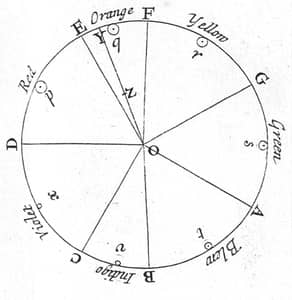
In the sixteenth century, Milanese artist Giuseppe Arcimboldo – best-known for his imaginative portraits showing human heads made of fruits and vegetables – carried out the first experiment that we know of to find naturally occurring relationships between sound and color. He did this by consulting with a musician and attaching colored strips to the keys of a gravicembalo, a keyboard-type instrument. Later, in the seventeenth century, physicist Isaac Newton attempted unsuccessfully to pin down naturally-occurring relationships between sounds and colors, using mathematics and frequencies to assign musical notes to the colors on the color wheel.
Symbolism and Impressionism
Attempts to connect color with sound saw a resurgence across the late nineteenth and early twentieth centuries as artists, particularly painters, began to look beyond the boundaries of conventional figurative representation for inspiration. The root of much of this was in Romantic poetry of the late eighteenth and early nineteenth centuries, such as the work of Byron and Keats, in which descriptions of natural phenomena often involve “sense transferral” that is, the description of something seen as if it could be heard, and so on. This reflected the Romantic poets interest in intense subjective psychological experience and their Pantheistic sense that all things in nature contained divine essences. But it was not for several more decades that visual art began to make more profound use of similar ideas.
During the late nineteenth century, the symbolist group of painters set out to create what artist Ksenija Pantelíc calls “musical paintings.” Symbolist poets such as Stéphane Mallarmé and Arthur Rimbaud were similarly interested in color-sound affinities. Rimbaud’s 1871 poem “Voyelles,” or “Vowels,” begins: “Black A, white E, red I, green U, blue O: you vowels,/ Some day I’ll tell the tale of where your mystery lies.”
Around the same era the Impressionist movement movement, which stressed the importance of subjective perception in ensuring artistic vision, also had an influence on attempts to utilize synesthesia in art. Many artists created works based on inferred associations between color and emotion as well as between color and sound at this time. The most famous of these was perhaps the Anglo-American James McNeill Whistler, whose Nocturne paintings, created at the time the Impressionists were working, took inspiration from the emotive content of music.
American painters of the same and subsequent generations, including George Inness, George Bellows, John Sloan, and Randall Davey, influenced by Impressionism but working within movements as diverse as the Hudson River and Ashcan schools, applied theories of synesthesia to landscape painting. They were partly reaching back to the Romantic, Pantheistic view that nature holds hidden powers which, when revealed, can unlock strange new heights of human emotion.
Synchromism
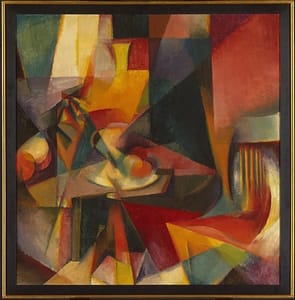
The American painters Stanton Macdonald-Wright and Morgan Russell pioneered the movement known as Synchromism (referring to “a symphony of colors”), perhaps the modern art movement most explicitly based on an idea of synesthesia. These artists produced paintings, called “synchromies,” by attempting to arrange colors on a canvas in the same way that musical notes are arranged in a composition. More precisely, they sought to produce mathematically-based visual harmonies based on the color-sound system, linking the twelve colors of the color wheel with the twelve notes of the chromatic scale. The approach was outlined in most detail by Canadian painter Percyval Tudor-Hart.
Other artists to experiment with Synchromism included Arthur B. Davies, Patrick Henry Bruce, Albert Henry Krehbiel, Thomas Hart Benton, and Andrew Dasburg. As South explains, not only were these artists interested in the association between sounds and colors, but also with a wider range of affinities between shapes, forms, and rhythms. “The Synchromists believed that the principal of weight shift (known as contrapposto) observed in classical figures, especially Greek sculpture, presented itself as a basic visual rhythm, like the ‘one-two, one-two’ beat of walking or ‘common time’ in music. Understood as a visual formula, contrapposto looks much like two curves in opposition to one another: ( ).”
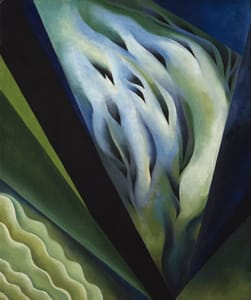
In the late 1910s, the Synchromists essentially abandoned their endeavors towards synesthetic composition. This was largely because the color-sound systems they devised did not allow for the artist’s subjectivity and intuition to play much of a role. Their theories had a lasting influence, however, notably on Georgia O’Keeffe, who produced a series of “color/music” paintings during the late 1910s and early 1920s. A couple of decades later, American painter Walt Kuhn also attempted to create paintings based on correlations between sounds and colors, though he allowed himself to discover these correlations intuitively, rather than relying on a set “scale.”
Expressionism, Constructivism and Concrete Art
Synchromism was not the only modern art movement concerned with synesthesia. In the early twentieth century, the artists of the German Expressionist group Der Blaue Reiter carried out experiments regarding the possible synthesis of visual art with musical compositions and dance choreography. The most famous member of the group, Wassily Kandinsky, transcribed some of his ideas in his 1910 book Concerning the Spiritual in Art. “Color is the keyboard,” Kandinsky writes, “the eyes are the harmonies, the soul is the piano with many strings.” He asserts that “[t]he sound of colors is so definite that it would be hard to find anyone who would express bright yellow with base notes, or dark lake with the treble.” Kandinsky produced several paintings inspired by musical compositions.
Following the example of Expressionism and other northern-European modernist movements such as Constructivism, in the mid-twentieth century the German-American Josef Albers attempted to create a correlative “scale” associating colors with emotional states. Indeed, the Constructivist movement as a whole, which had its roots in revolutionary Russia and Germany during the 1910s-20s, could be seen as an attempt to find compositional approaches that would apply across different media, an idea strongly connected to synesthesia.
Synesthesia and Modernist Music
The early twentieth-century German concept of the gesamtkunstwerk (“total work of art”), influenced by Wagner’s theories of operatic form, promoted the idea that various elements of a “composition" (whether in music or some other art form) could be planned in such a way that their emotive and sensory effects overlapped. The impact of this idea was partly in fields such as architecture and interior design. Various modernist composer-artists of this era, such as the Austrian-American painter and composer Arnold Schoenberg, and Lithuanian painter and composer Mikalojus Konstantinas Čiurlionis, explored ideas of multisensory form in a way which applied directly to music.
The rise of graphic musical scores in the mid-to-late twentieth century, whereby performers were invited to intuit certain sonic equivalents to unfamiliar visual symbols, could be seen partly as the legacy of earlier modernist attempts to pin down synesthetic equivalencies between visual and sonic form. Pioneers of this form of composition include Earle Brown, John Cage, Morton Feldman, and Cornelius Cardew.
Concepts and Styles
Chromesthesia in Art
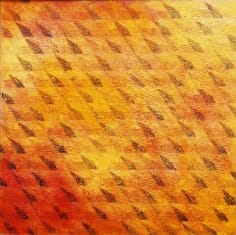
The most common form of synesthesia is chromesthesia, in which the individual has the experience of “seeing” particular colors when they hear certain sounds, voices, or musical arrangements. Many synesthete artists attempt to convey these associative experiences through their art, for instance, by painting what they “see” when they hear a certain song. Artist Melissa McCracken explains how this visual experience functions, stating that “[s]ynesthesia doesn't interfere with my sight in any way and it's not hallucinogenic. It just floats there in a similar way to how you would imagine something or visualize a memory.”
Outlining some of the specifics of her experience, McCracken states: “[i]t flows in a mixture of hues, textures, and movements, shifting as if it were a vital and intentional element of each song.” She adds: “[e]xpressive music such as funk is a lot more colorful, with all the different instruments, melodies, and rhythms creating a highly saturated effect. Guitars are generally golden and angled, and piano is more marbled and jerky because of the chords. I rarely paint acoustic music because it's often just one person playing guitar and singing, and I never paint country songs because they're boring muted browns. The key and tone also has an impact, so I try and paint the overall feeling of the song”.
These experiences differ from one synesthete to another. Curious about whether other synesthetes “see” songs the same way as she does, McCracken once engaged in an experiment with another synesthete artist, in which they both painted “Little Wings” by Jimi Hendrix. She says “our final pieces looked totally different, proving how subjective it is.”
Other Forms of Synesthesia in Art
Some artists experience rarer forms of synesthesia, such as lexical-gustatory synesthesia (in which certain words or sounds evoke particular tastes), ordinal linguistic personification (in which ordered sequences, like numbers, letters, days, months, etcetera, possess distinct personality traits and even genders), and hearing-touch synesthesia (in which certain sounds cause the individual to feel particular tactile sensations). For example, in addition to chromesthesia and autism, San Diego-based artist Jeremy Sicile-Kira has emotion-color synesthesia, meaning that certain emotions evoke certain colors in his mind. Meanwhile, New England-based artist Alyn Carlson experiences Grapheme-color synesthesia (such as seeing numbers as having specific colors, sounds, and even smells), and believes that without this unique form of perceiving the world, she would most likely not be working as an artist.
Form Constants
Many synesthetic artists report a similar range of geometrical visual effects. These are often called form constants, and they overlap with those experienced during hypnagogia, hallucinations, and other forms of altered consciousness. Of particular relevance are the form constants identified in 1926 by the German-American psychologist and philosopher Heinrich Klüver, who coined the phrase.
Klüver systematically studied the effects of mescaline (peyote) on his own and others’ fields of vision. He found that mescaline produced recurring geometric patterns across a range of subjects, allowing him to identify four common types of visual effect: chessboard patterns, cobwebs, tunnels, and spirals. These patterns are often visually experienced by synesthetes, and can be found in much synesthetic art.
Synesthetic Art by Non-Synesthetes
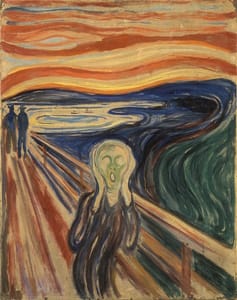
Throughout history, many artists who haven’t experienced synesthesia have nevertheless concerned themselves with depicting synesthetic experience. The synchromists, like Stanton Macdonald-Wright and Morgan Russell, attempted to create paintings based on a system which correlated particular colors with particular musical notes. The symbolists and the romantics were also fascinated with synesthesia, as they searched for a way to make their art connect the viewer to the hidden, spiritual realms that exist in nature.
Synesthesia and the Romantic Impulse in Art
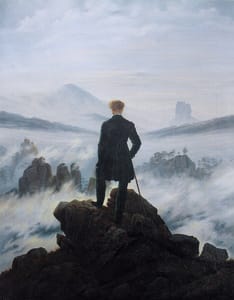
The Romantic era was the period when the seeds of later artistic interest in synesthesia were sown. The hallmarks of this period include an interest in intense psychological experiences and emotions, and attempts to capture the divine or “sublime” power of nature. Writing on the subject of the sublime in 1781, German philosopher Immanuel Kant noted that "whereas the beautiful is limited, the sublime is limitless, so that the mind in the presence of the sublime, attempting to imagine what it cannot, has pain in the failure but pleasure in contemplating the immensity of the attempt.”
Artists of this time were interested in visually expressing the concept of the sublime, which seemed to defy the limits of standard human perception. Kant wrote: “the very inadequacy of our faculty for estimating the magnitude of the things of the sensible world awakens the feeling of a supersensible faculty in us.” He asserted that the sublime even creates a sense of dissatisfaction “emerging from the incapacity of vision in the aesthetic assessment of size to rise to its assessment of logic.” In short, the sublimity of nature created an urge to push beyond standard forms of expression in order to render it, perhaps even to rupture the boundaries between senses and media.
This is not to say that Romantic artists necessarily attempted to render synesthetic effects in their work. However, later developments in synesthetic art can be seen as rooted in a romantic interest in somehow capturing and relaying states, experiences, and scenes that defied normal human thought and emotion.
Later Developments
Scientific Developments in Defining Synesthesia
Contemporary synesthete artists benefit from living at a time when awareness of synesthesia is becoming more commonplace. Neuroscientist Richard Cytowic says, “[w]hat it does for the population in general is expand their empathy. Once you learn about synesthesia and that people see the world much differently than you do, it opens your mind up, and you’re much more empathetic to other people.”
Many contemporary synesthete artists, like Americans Diana de Avila and Carol Steen, use digital technologies to more accurately represent their experiences. For de Avila, Steen, and many others, software that allows the user to create fractal art is particularly helpful for depicting Klüver’s form constants in their works.
Synesthesia and New Art Forms
The term “synesthesia” has more recently appeared in art history and art criticism as a way to describe the unique ‘viewing’ experience afforded by new art forms, like Installation and performance work. Art historian and curator Jacques Talbot asserts that “by invoking senses other than sight, installation heightens the embodied exhibition experience through the proximal interaction necessary to engage these senses.” He bases this stance upon Eilean Hooper-Greenhill’s description of vision as “the least personal of the senses.” Other senses, Hooper-Greenhill states, “need us to be close to things, and [so] require intimacy and … enable familiarity. They involve the body more.” Indeed, one significant way in which much contemporary art departs with its historical precedents is the decreased status of visuality in favour of multi-sensory and inter-media work.
Art critic Arthur Danto and philosopher Peter Osborne both assert that visuality has become less important in much contemporary art, with Osborne going so far as to identify visuality as contemporary art’s “least distinguishing trait.” Art historian Margarita Dikovitskaya offers a less hyperbolic explanation, asserting that “visuality should be thought about in terms of a matrix of experience that includes all of the five senses interwoven.” Indeed, much contemporary art encourages what cultural theorist Mieke Bal describes as “synaesthetic” reception, often creating experiences in which multiple senses are engaged simultaneously, thereby returning the focus of experience to the body and the way that the body encounters, and makes sense of, the world through the senses.
Useful Resources on Synesthesia
- Color, Myth, and Music: Stanton Macdonald-Wright and SynchronismOur PickBy Will South
- Morgan RussellBy Marilyn S Kushner
- Portrait of an Artist: A Biography of Georgia O'KeeffeOur PickBy Laurie Lisle
- The Hidden Sense: Synesthesia in Art and ScienceOur PickBy Cretien Van Campen
- The Oxford Handbook of SynesthesiaBy Julia Simner and Edward M. Hubbard
- Synesthesia and the ArtsBy Dani Cavallaro
- The Unknown Unknowns: Creativity, Arts and Ideasthesia (Extreme Synesthesia)By Vera Dragilyova
- Sensory Crossovers: Synesthesia in American ArtOur PickBy Sharyn R. Udall and Nancy Weekly
- Visual Music: Synaesthesia in Art and Music Since 1900Our PickBy Kerry Brougher, Jeremy Strick, Ari Wiseman, and Judith Zilczer
- Synaesthetics: Art as SynaesthesiaBy Paul Gordon
 Ask The Art Story AI
Ask The Art Story AI